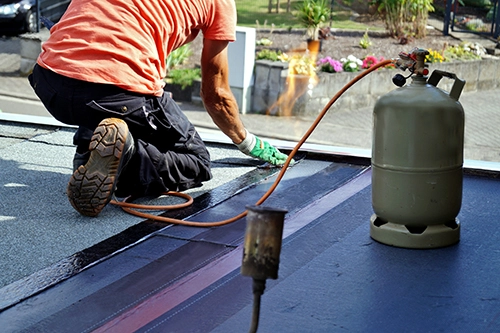- About Us
- Services
- Blog
- Contact
Need a quote?
Commercial roofing can be expensive, especially if you don’t choose the right material. Every material has its pros and cons, suited for different buildings and different situations.
It would be impossible to cover all the potential types of commercial roofing in one article, but nonetheless, we’d like to at least provide an idea of what to think about when making your decision. That’s why today we’ll be covering the three vital questions to consider when choosing your roof material as well as the potential risks some materials could pose.




When it comes to commercial roofing, research matters. The most common options you’ll come across are single ply, BUR (built-up roofing), and metal, each of which are appropriate for different circumstances.
BUR is a traditional option that is still widely used. The approach of using multiple layers is good for waterproofing and a gravel surface can be more pleasant to look at than other choices. Metal, on the other hand, is long-lasting and low-maintenance, which is particularly good for large buildings such as warehouses and factories, where roof maintenance and replacement can be an expensive affair.
Alternatively, you might also try one of the many eco-friendly roofing materials, which have recently grown particularly popular in urban environments.
No matter which material you choose, it’s important to note that there will be risks. Some materials are less weather-resistant than others. Some have a higher cost of upkeep. Some materials work far better on flat roofs than sloped ones and vice versa.
When you do make your choice, be sure to be aware of the potential downsides so you can take steps to prepare for and mitigate any damage that may occur over time.
Of course, even with all that in mind, it can be tempting to look for the most affordable materials for the job. While short-term cost effectiveness is certainly worth considering, our recommendation is always for long-term viability. After all, although every roof has a lifespan, that lifespan is largely decided by the quality of the materials used.
Indeed, modern roofs tend to last far longer than roofs built in previous decades for just this reason. Likewise, investing more money upfront could save you a lot in the long run.
To learn more about the various commercial roofing materials available to you, please contact us today by calling 020 3535 6957 or emailing info@environroofingservices.co.uk.
It depends on the construction, but the minimum weight a flat roof must be capable of bearing is 300lbs. This refers to a concentrated weight where a load is positioned on just one area of the roof. So, for example, a commercial flat roof can approximately support a 300lb HVAC unit in a 2.5×2.5ft single space.
If you opt for a flat roof anywhere on your property, remember that it comes with a need for proper maintenance. Low-slope roofing London-wide should be checked every six months or so, or after spells of bad weather, to spot any signs of damage. No matter how small, these should be addressed before they escalate. Remove any debris (leaves, twigs and so on) regularly to avoid these blocking the gutters and allowing water to pool and stand on the roof.
If there are trees in the close vicinity, keep them cut back to reduce the amount of foliage that falls on your flat roof. And check internally for signs of moisture, dampness or water damage on a regular basis. Spotting problems early means resolving them will be cheaper in the long run.

Building a flat roof can be done in three ways. The simplest and most cost-effective choice for levelled roofing London-wide is to construct a warm roof where a roofing membrane is placed over the insulation that keeps the timber structure warm. Another option is to create a cold roof where insulation is positioned between the rafters under the ply roof covering. This is commonly applied to flat-roofed extensions.
The third method is the hybrid roof that contains diverse elements. Their designs require a gap of ventilation above a warm roof to prevent excess moisture within the roof structure.
If you’re looking for flat roofing local contractors, don’t just select the first firm you come across. Find a roofing company that’s been in business for a while and can demonstrate a good track record in installing, repairing, and replacing flat roofs specifically. Ask for recommendations from your own network or from a local trade association. If you need refurbishment work done to 50% or more of your roof, you’ll need a roofing contractor who can self-certify their work under the Competent Person Scheme. Otherwise, the Building Control department at your local authority will need to approve the job before it begins.
Ask whether they are covered by liability insurance and how long they’ll guarantee the work they will carry out. And never just opt for the cheapest quote unless you’re quite sure they’re the best company for the job. You can’t afford to compromise on your roof as the structural integrity of your property depends on it.
Ensuring your flat roof will comply with building regulations before installation can save property owners time, money and stress. First, the roof must have a slope of around 1:80, with water draining away to one or two roof edges. Waterproofing must be extended up to the adjacent walls with at least 150 mm from the surface of the roof.
Contractors must install ventilation in cold roofs. For warm roofs, the deck must be bonded with a VCL. The roof should have the capacity to withstand strong winds and be sturdy enough to take an individual’s weight. Finally, check whether planning permission is needed. Typically, this is only required if you live in a conservation area or a listed building, or are making significant changes to an existing roof.
If you’re looking for top roofing solutions at competitive rates, check out our range of roofing services at Environ Roofing Company London. To get started, call one of our representatives today!

